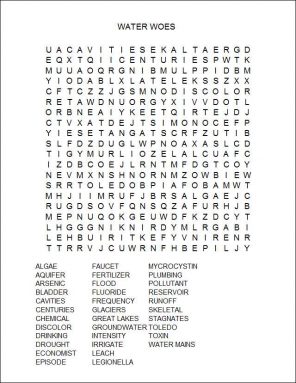Will water woes leave Americans thirsty?
Even in the United States, water quality and quantity can suffer
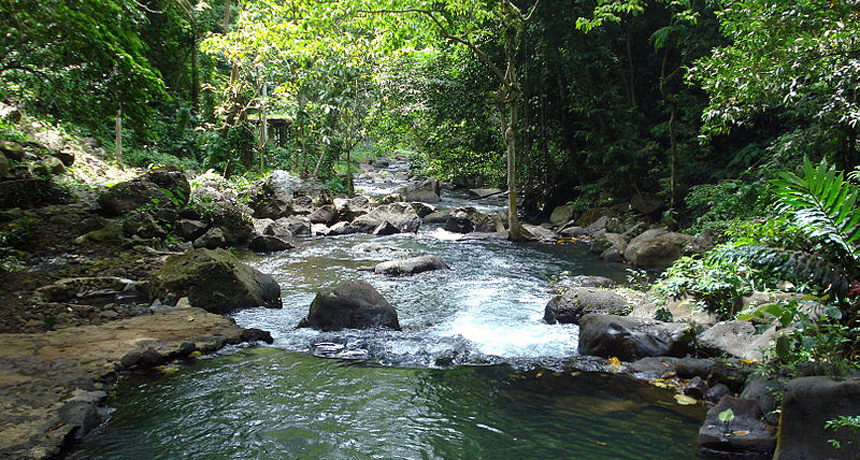
Even where water appears plentiful, as here, you can’t tell by sight whether it’s safe to drink. Pollution or microbes may render it toxic. In many other areas, water sources are drying up — making people turn to bottled water to slake their thirsts.
GinaD/ Wikimedia Commons (CC-BY-SA-3.0)
On August 2, 2014, residents of Toledo, Ohio, woke up to a startling warning from the city: “DO NOT DRINK THE WATER.”
A few samples from the city’s water-treatment plant contained worrisome levels of a toxic chemical. Algae in Lake Erie, where Toledo gets its water, made this toxin. Drinking water with this chemical — called microcystin — could make people sick. And boiling the water would only evaporate some of the liquid, concentrating the toxin in what was left behind.
Those algae that make this toxin live in Lake Erie and many other lakes and streams. Normally, they pose no problem. But in the spring, fertilizer washes off of farms and into rivers that drain into open waters. That fertilizer contains two nutrients: nitrogen and phosphorus. Algae will gobble them up. In no time at all, their growth can skyrocket, forming what’s known as an algal bloom. And that’s what happened in Lake Erie this past summer.
“It is like we’re giving all of this algae candy,” says Isabel Escobar. She’s a professor of chemical and environmental engineering at the University of Toledo.
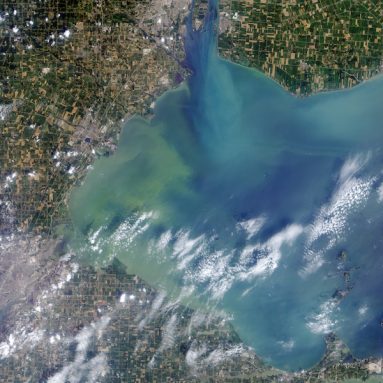
Waking up to hear that the water coming into your house is dangerous to drink can be scary. But it’s also a sign that the rules put in place to protect drinking water do work. Two days after the notice went out to Toledo residents, it was canceled. Water treatment engineers had figured out how to remove the toxin and make the city’s drinking water safe.
But what happened in Toledo is a reminder that even in wealthy countries like the United States, clean water isn’t always available everywhere. “Society is growing and our water resources aren’t,” notes Andrea Dietrich. She’s an environmental engineer at Virginia Tech in Blacksburg. Clean drinking water “is a limited resource and we have to value it,” she says.
Clean water rules
American lakes, rivers and streams used to be much more polluted than they are today. At one point in 1969, the oil and debris floating on the Cuyahoga River in Cleveland, Ohio, actually caught on fire. The Cuyahoga River fire was one incident that helped spur passage of the Clean Water Act in 1972. Now, factories no longer can dump their wastes directly into rivers and streams. Those caught doing that — either on purpose or by accident — are fined.
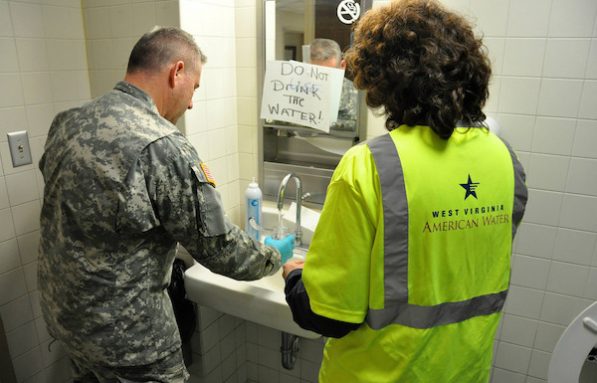
Such runoff can pick up and carry other pollutants, including pesticides and weed killers. More than half of all streams that drain farm regions have levels of pesticides high enough to harm aquatic life. And 90 percent of waterways in and near cities also contain high amounts of these chemicals. Those are the results of a study by the U.S. Geological Survey (USGS). Wesley Stone and his colleagues published their findings September 11 in Environmental Science & Technology.
But even the threat of fines won’t keep all industry pollution from waterways. In January 2014, a chemical called crude MCHM leaked out of a storage facility in West Virginia and into the Elk River. That river is a source of drinking water for many communities downstream. “When the chemical spilled, there was very limited data on its safety, transport and toxicity,” says Dietrich. “That was a major problem.” For 10 days, some 300,000 people could not use their drinking water for anything — even showers.
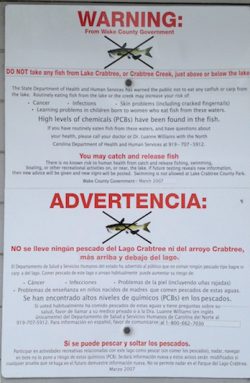
Many people get their drinking water from underground sources, called aquifers. And pollution can seep into these too. For instance, USGS officials recently warned that the underground flow of a mass of salty water threatens the drinking water of Wichita, Kan. The pollution’s source: activities in the 1930s to remove oil and gas from a place about 32 kilometers (20 miles) away.
Rocky matters
Some water may be unsafe to drink due to natural pollution. Groundwater aquifers can hold huge amounts of water. Such aquifers aren’t big, underground pools, though. An aquifer is a layer of rock, sand or gravel in which water accumulates. Toxic chemicals may leach out of these materials and into water. That’s why fluoride and arsenic naturally contaminate many U.S. water supplies.
A little bit of fluoride is healthy. This chemical can help prevent cavities from forming in teeth. That’s why manufacturers add it to toothpaste. Many communities also add small amounts of it to drinking water. But in some areas of the country, such as Maine and parts of New York, fluoride leaches out of rock and into groundwater. Too much fluoride can discolor or pit teeth and cause skeletal problems. There also is some evidence that childhood exposure to high levels of fluoride may reduce IQ.
Arsenic, in contrast, is never healthy. Long-term exposure can lead to cancer of the skin, bladder or kidneys. Scientists argue over how much someone can consume without harm. The U.S. Environmental Protection Agency (EPA) currently sets the acceptable level for arsenic in drinking water at 10 parts per billion. But in many parts of the United States — including areas of Texas, New England, Michigan, California and Idaho — arsenic in groundwater naturally exceeds that level. Again, the weathering of rocks and soil can release this toxic element into the water.
The good news is that treatments exist to remove arsenic from water.
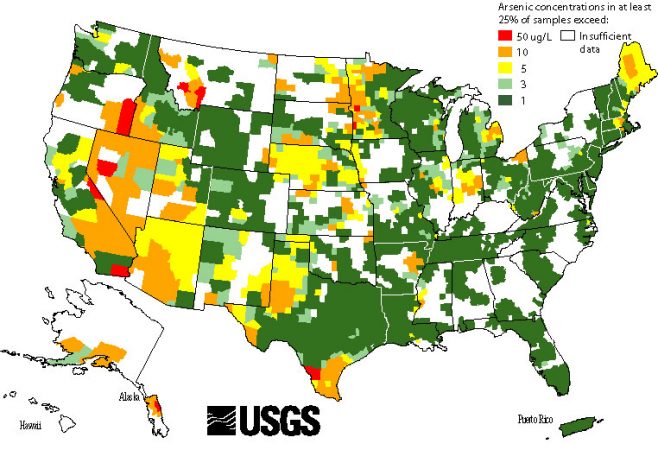
Removing fluoride is more difficult and more expensive. But in the United States, people usually have the option to get water from somewhere else, such as piping it in from another city or buying it in bottles. Poor people, however, may lack this option. “They’re least able to pay for individual solutions to water problems, like water filters or bottled water,” says Peter Gleick. He’s a water expert and president of the Pacific Institute. This non-profit group in Oakland, Calif., is studying how people can use resources sustainably.
Old, leaky pipes
The EPA sets national limits for many pollutants in drinking water. States may set even stricter limits. These rules are meant to ensure that water is safe. The companies that supply drinking water to people regularly have to test for contaminants. That’s how city officials learned of the high toxin levels in Toledo’s water. And when pollution exceeds allowed levels, a drinking-water provider must do something to bring the water into a safe range.
But even if the water leaves a treatment plant clean, what later comes out of your home faucet might not be.
That’s because your water can pick up pollutants as it flows through pipes to and through your home. In many places, those pipes are old and need replacing. “There are many ways that an outdated system can fail us in transporting clean, safe water to our homes,” says Marc Edwards. He’s an environmental engineer at Virginia Tech.
“The water distribution networks that bring clean water from the treatment plant to your house have been neglected for almost a century,” Edwards says. A few pipes are so old they are made of wood. A large number of iron and cement pipes leak. That causes water to be lost from the system. And that’s a waste of money, especially when the water already has been treated to clean it up.
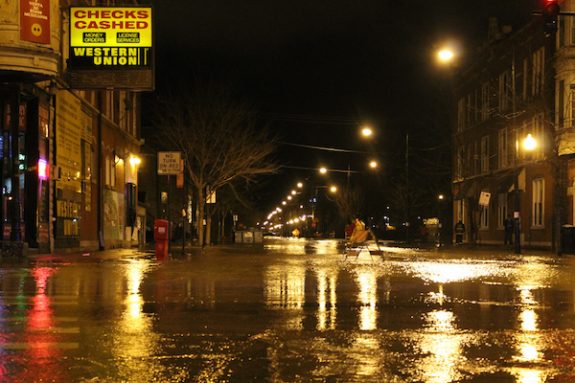
Old, rusty pipes often develop big holes. And these can let in bacteria from the surrounding soil. Disease-causing germs often live in the soils right next to those pipes, studies have shown. People rarely notice problems with such pipes, called water mains, until they break. But those breaks do occur. They happen around 240,000 times every year in the United States alone.
The situation is so bad that in 2013 the American Society of Civil Engineers gave the nation’s drinking-water system a grade of D (on a scale of A to F). The American Water Works Association estimates that it could take more than $1 trillion to fix the problems.
“These pipes very often are unlined iron,” Edwards explains. “If you ever saw what some of these pipes look like, it would turn your stomach. They’re very thick with rust and bacteria.” Disinfectants such as chlorine and chloramine often are added to the water to clean it. That kills the bacteria but can create new problems.
In many places, at least some of the pipes that water flows through are made of materials that contain lead, a very toxic heavy metal. Faucets or the connections between pipes also may contain lead. Usually the lead stays out of the water. But some water treatments, such as chloramine, can cause the lead to leach out.
And that’s a concern because lead is especially dangerous for children. Because lead affects the brain, even small amounts can cause learning difficulties, behavior problems and a permanent drop in IQ. Other symptoms include headaches, irritability and abdominal pain. Lead leaching happens in many homes and businesses. Edwards’ team has even found toxic levels of lead leaching from the water fountains in U.S. public schools.
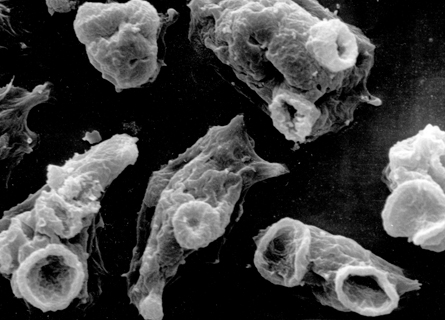
And then there are some worrisome, blob-shaped amoebas. A major 2011 report found that these single-celled organisms taint drinking water systems around the world. Some may cause diseases that blind or kill by eating brain cells. Others work like a Trojan horse; the amoebas ferry disease-causing bacteria within them — and protect those germs from the chemicals used to treat drinking water.
Once bacteria — from any source — get into water, they can set up long-lived colonies within the pipes inside your house or apartment building. “Most people don’t realize it, but it’s bacteria that grow in your house in your water pipes that is the number one source of water disease in the United States,” Edwards says. One concern is Legionella. These bacteria cause Legionnaire’s disease, a potentially deadly form of pneumonia. Within just the United States, this disease sickens some 8,000 to 18,000 people every year.
New water systems are not free of problems either. “Green” plumbing systems are meant to help people conserve water. But in some, the water stagnates in the pipes for too long. “Just like milk can go bad if you let it sit around in a warm room for a period of time, so too can water go bad,” Edwards says. Even if the water isn’t dangerous, it may taste bad. So people may end up buying bottled water. Bottled water is less environmentally friendly. Lots of energy and other resources go into making the plastic bottle and in transporting the water to stores.
Scarce water
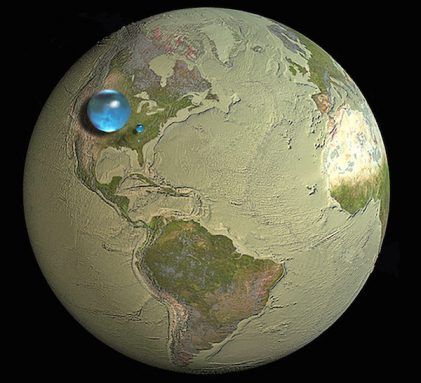
Water covers about 71 percent of Earth’s surface. Most of that water can’t be used to slake the thirst of people and crops. The majority sits in the oceans, too salty to drink. Liquid freshwater accounts for only a small amount — about 2.5 percent of all water on Earth, according to USGS. Of that freshwater, more than two-thirds is locked in glaciers and in the ice caps of the Arctic and Antarctic. Much of the rest is underground.
In fact, only 1.2 percent of all freshwater is surface water — the water in lakes, streams and rivers. North America has more than its share of that freshwater. About one-fifth of the world’s freshwater sits in just its five Great Lakes. A smaller volume fills America’s other lakes, as well as its rivers and streams. More sits in underground aquifers.
But all of that freshwater isn’t distributed equally. The Great Lakes’ water doesn’t flow through the taps of homes in the U.S. Southwest, for instance. Yet that area has a large and growing population. And its climate remains fairly dry.
Some western states are even experiencing drought. California’s current drought began years ago, and there is no sign it’s about to end. Rivers and reservoirs have begun to dry up. Increasingly, people now rely on wells that tap into groundwater for the water that will be used for drinking and for irrigating crops. As a result, groundwater supplies have been shrinking. And that’s worrisome.
Groundwater aquifers can take years, even centuries, to refill. They are not an unlimited resource. Indeed, some wells have already gone dry. People in at least one California town, East Porterville, already must rely on bottled water. More than a dozen other communities could soon follow suit.
Scientists are concerned that the situation in California may foreshadow the future elsewhere. Global warming is changing Earth’s climate in ways that are expected to increase the frequency and intensity of episodes of too little or too much water. “We know that our water systems are vulnerable to climate change… and extreme events like floods and droughts,” says Gleick of the Pacific Institute.
That presents a problem about how best to manage water supplies. The situation can be particularly bad when water isn’t plentiful. Droughts are one example of this. But in some areas, such as the arid Southwest, water supplies may always be limited. Decisions will have to be made about who gets water at times when it isn’t plentiful.
Such conversations rarely take place, except when there is a drought, notes Greg Characklis. He’s an engineer and economist at the University of North Carolina at Chapel Hill.
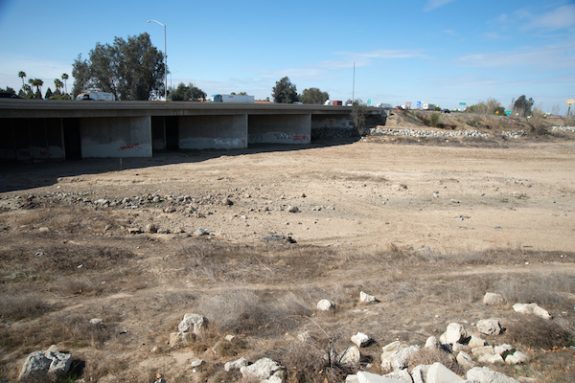
One way to manage a limited resource is to use it more efficiently. That’s why it’s a good idea to turn off the faucet when you brush your teeth. And it’s why people are told not to water their lawns during a drought.
But in the United States, farms consume most of the water. It irrigates crops.
Even a little bit better efficiency in water use by farms would go a long way toward alleviating a lot of the concerns we have about water, says Characklis.
It’s especially important that people understand where water comes from, how it gets used and how it cycles through the natural environment, adds Gleick. And through that understanding, “it will be easier to make smarter decisions about our water future.”
Power Words
agriculture The growth of plants, animals or fungi for human needs, including food, fuel, chemicals and medicine.
algae Single-celled organisms, once considered plants (they aren’t). As aquatic organisms, they grow in water. Like green plants, they depend on sunlight to make their food.
amoeba A single-celled microbe that catches food and moves about by extending fingerlike projections of a colorless material called protoplasm. Amoebas are either free-living in damp environments or they are parasites.
aquatic An adjective that refers to water.
aquifer Rock that can contain or transmit groundwater.
arid A description of dry areas of the world, where the climate brings too little rainfall or other precipitation to support much plant growth.
arsenic A highly poisonous metallic element. It occurs in three chemically different forms, which also vary by color (yellow, black and gray). The brittle, crystalline (gray) form is the most common. Some manufacturers tap its toxicity by adding it to insecticides.
bacterium (plural bacteria) A single-celled organism. These dwell nearly everywhere on Earth, from the bottom of the sea to inside animals.
bloom (in microbiology) The rapid and largely uncontrolled growth of a species, such as algae in waterways enriched with nutrients.
cancer Any of more than 100 different diseases, each characterized by the rapid, uncontrolled growth of abnormal cells. The development and growth of cancers, also known as malignancies, can lead to tumors, pain and death.
cell The smallest structural and functional unit of an organism. Typically too small to see with the naked eye,it consists of watery fluid surrounded by a membrane or wall. Animals are made of anywhere from thousands to trillions of cells, depending on their size.
chemical A substance formed from two or more atoms that unite (become bonded together) in a fixed proportion and structure. For example, water is a chemical made of two hydrogen atoms bonded to one oxygen atom. Its chemical symbol is H2O.
chemical engineer A researcher who uses chemistry to solve problems related to the production of food, fuel, medicines and many other products.
chloramine A chemical sometimes used to disinfect drinking water supplies. Water-supply companies can induce them to form by adding ammonia to the chlorine used to treat some drinking water. Chloramine has been used for nearly a century.
chlorine A chemical element with the scientific symbol Cl. It is sometimes used to clean water. Compounds that contain chlorine are called chlorides.
climate change Long-term, significant change in the climate of Earth. It can happen naturally or in response to human activities, including the burning of fossil fuels and clearing of forests.
disinfect To clean an area by killing dangerous infectious organisms, such as bacteria.
drought An extended period of abnormally low rainfall; a shortage of water resulting from this.
economics The social science that deals with the production, distribution and consumption of goods and services and with the theory and management of economies or economic systems. A person who studies economics is an economist.
element (in chemistry) Each of more than one hundred substances for which the smallest unit of each is a single atom. Examples include hydrogen, oxygen, carbon, lithium and uranium.
engineer A person who uses science to solve problems. As a verb, to engineer means to design a device, material or process that will solve some problem or unmet need.
environmental engineer A person who uses science to study and improve the natural environment.
Environmental Protection Agency (or EPA) An agency of the federal government charged with helping create a cleaner, safer and healthier environment in the United States. Created on Dec. 2, 1970, it reviews data on the possible toxicity of new chemicals (other than food or drugs, which are regulated by other agencies) before they are approved for sale and use. Where such chemicals may be toxic, it sets rules on how much may be used and where it may be used. It also sets limits on the release of pollution into the air, water or soil.
fertilizer Nitrogen and other plant nutrients added to soil, water or foliage to boost crop growth or to replenish nutrients that removed earlier by plant roots or leaves.
fluoride A chemical, such as sodium fluoride, that contains the element fluorine. In small doses, fluorides can help prevent tooth decay.
global warming The gradual increase in the overall temperature of Earth’s atmosphere due to the greenhouse effect. This effect is caused by increased levels of carbon dioxide, chlorofluorocarbons and other gases in the air, many of them released by human activity.
infrastructure The underlying structure of a system.
insect A type of arthropod that as an adult will have six segmented legs and three body parts: a head, thorax and abdomen. There are hundreds of thousands of insects, which include bees, beetles, flies and moths.
IQ or intelligence quotient A number representing a person’s reasoning ability. It’s determined by dividing a person’s score on a special test by his or her age, then multiplying by 100.
leach (in geology and chemistry) The process by which water (often in the form of rain) removes soluble minerals or other chemicals from a solid, such as rock, sand, soil or ash.
lead A toxic heavy metal (abbreviated as Pb) that in the body moves to where calcium wants to go. The metal is particularly toxic to the brain, where in a child’s developing brain it can permanently impair IQ, even at relatively low levels.
Legionnaire’s disease A bacterial infection in the lungs that causes inflammation and potentially deadly pneumonia that was first identified in 1977. Of more than 40 types of Legionella germs identified to date, more than 20 cause human diseases. Those illness are known as Legionelloses.
microcystins A class of toxins produced by some freshwater algae that are also known as cyanobacteria. Most of these toxins work by poisoning the liver.
parts per million (or billion, or trillion) Frequently abbreviated as ppm (or ppb or ppt), it is a measure of the number of units of some material that have been mixed into another. The units should be the same (or equivalent) for both materials. So 3 ppb lead in water would be 3 parts of lead in every billion parts of water.
pesticide A chemical or mix of compounds used to kill insects, rodents or other organisms harmful to cultivated plants, pet or livestock, or unwanted organisms that infest homes, offices, farm buildings and other protected structures.
phosphorus A highly reactive, nonmetallic element occurring naturally in phosphates. Its scientific symbol is P.
pneumonia A lung disease in which infection by a virus or bacterium causes inflammation and tissue damage. Sometimes the lungs fill with fluid or mucus. Symptoms include fever, chills, cough and trouble breathing.
pollutant A substance that taints something — such as the air, water, our bodies or products. Some pollutants are chemicals, such as pesticides. Others may be radiation, including excess heat or light. Even weeds and other invasive species can be considered a type of biological pollution.
polychlorinated biphenyls (or PCBs) A family of 209 chlorine-based compounds with a similar chemical structure. They were used for many decades as a nonflammable fluid for insulating electrical transformers. Some companies also used them in making certain hydraulic fluids, lubricants and inks. Their production has been banned in North America and many countries throughout the world since around 1980.
reservoir A large store of something. Lakes are reservoirs that hold water. People who study infections refer to the environment in which germs can survive safely (such as the bodies of birds or pigs) as living reservoirs.
sustainability To use resources in a way that they will continue to be available in the future.
toxic Poisonous or able to harm or kill cells, tissues or whole organisms. The measure of risk posed by such a poison is its toxicity.
toxin A poison produced by living organisms, such as germs, bees, spiders, poison ivy and snakes.
U.S. Geological Survey (or USGS) This is the largest nonmilitary U.S. agency charged with mapping water, Earth and biological resources. It collects information to help monitor the health of ecosystems, natural resources and natural hazards. It also studies the impacts of climate and land-use changes. A part of the U.S. Department of the Interior, USGS is headquartered in Reston, Va.
water main The primary pipe bringing drinking water to areas within an urban neighborhood. It is usually buried at least a meter (roughly 3 feet) below city streets.
weathering (in geology) The process of breaking down rocks and soil. Weathering can be chemical, such as by oxidation (rust), or mechanical, such as by water, ice, or wind.
